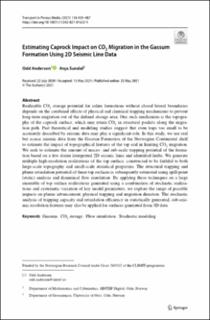| dc.contributor.author | Andersen, Odd | |
| dc.contributor.author | Sundal, Anja | |
| dc.date.accessioned | 2022-08-26T11:21:46Z | |
| dc.date.available | 2022-08-26T11:21:46Z | |
| dc.date.created | 2021-06-05T19:22:24Z | |
| dc.date.issued | 2021 | |
| dc.identifier.citation | Transport in Porous Media. 2021, 138, 459-487. | en_US |
| dc.identifier.issn | 0169-3913 | |
| dc.identifier.uri | https://hdl.handle.net/11250/3013771 | |
| dc.description.abstract | Realizable CO2 storage potential for saline formations without closed lateral boundaries depends on the combined effects of physical and chemical trapping mechanisms to prevent long-term migration out of the defined storage area. One such mechanism is the topography of the caprock surface, which may retain CO2 in structural pockets along the migration path. Past theoretical and modeling studies suggest that even traps too small to be accurately described by seismic data may play a significant role. In this study, we use real but scarce seismic data from the Gassum Formation of the Norwegian Continental shelf to estimate the impact of topographical features of the top seal in limiting CO2 migration. We seek to estimate the amount of macro- and sub-scale trapping potential of the formation based on a few dozen interpreted 2D seismic lines and identified faults. We generate multiple high-resolution realizations of the top surface, constructed to be faithful to both large-scale topography and small-scale statistical properties. The structural trapping and plume retardation potential of these top surfaces is subsequently estimated using spill-point (static) analysis and dynamical flow simulation. By applying these techniques on a large ensemble of top surface realizations generated using a combination of stochastic realizations and systematic variation of key model parameters, we explore the range of possible impacts on plume advancement, physical trapping and migration direction. The stochastic analysis of trapping capacity and retardation efficiency in statistically generated, sub-seismic resolution features may also be applied for surfaces generated from 3D data. | en_US |
| dc.language.iso | eng | en_US |
| dc.publisher | Springer | en_US |
| dc.rights | Navngivelse 4.0 Internasjonal | * |
| dc.rights.uri | http://creativecommons.org/licenses/by/4.0/deed.no | * |
| dc.subject | Gassum | en_US |
| dc.subject | CO2 storage | en_US |
| dc.subject | Flow simulation | en_US |
| dc.subject | Stochastic modeling | en_US |
| dc.title | Estimating Caprock Impact on CO2 Migration in the Gassum Formation Using 2D Seismic Line Data | en_US |
| dc.type | Peer reviewed | en_US |
| dc.type | Journal article | en_US |
| dc.description.version | publishedVersion | en_US |
| dc.rights.holder | © The Author(s) 2021 | en_US |
| dc.source.pagenumber | 459-487 | en_US |
| dc.source.volume | 138 | en_US |
| dc.source.journal | Transport in Porous Media | en_US |
| dc.identifier.doi | 10.1007/s11242-021-01622-1 | |
| dc.identifier.cristin | 1913912 | |
| dc.relation.project | Norges forskningsråd: 268512 | en_US |
| cristin.ispublished | true | |
| cristin.fulltext | original | |
| cristin.qualitycode | 2 | |

